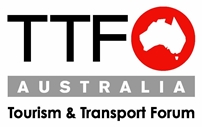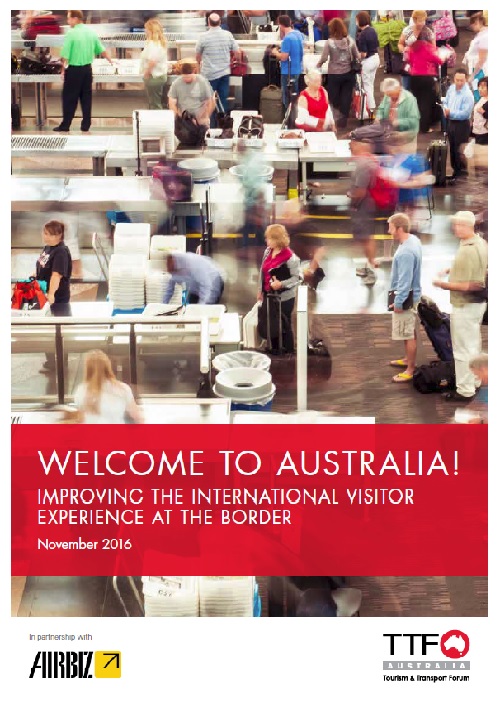
Report: Smart tech revolution the key to cutting queues and delivering a better experience at our international airports
A new report released today by the Tourism and Transport Forum Australia (TTF) urges the Federal Government to roll out world-leading border management technology to slash growing queues in our international airports and greatly improve the border experience for millions of Australians and international visitors travelling every year.
The report, “Welcome to Australia! Improving the International Experience at the Border”, produced for TTF by the specialist aviation consultancy Airbiz, identifies solutions to remove bottlenecks in international terminals, which create major delays for arriving and departing travellers, tainting the reputation of ‘Brand Australia’ immediately before or straight after a visit.
“We sell Australia as one of the world’s most memorable destinations, but increasingly we welcome and farewell our visitors with some of the most forgettable border experiences,” said TTF CEO Margy Osmond.
“Airport operators are working overtime to improve airports with refreshed and updated retail, dining and business facilities but we need Government to do its part by improving the border facilitation services for which it is responsible.
“If we are to meet our goal of being one of the world’s leading visitor destinations, we need to ensure that every part of the visitor experience, including the critical first and last impressions, is equal to or better than our global competitors.
“The fact that three in five people (60 per cent) stepping off an aeroplane in our international terminals are return visitors to Australia, it is vital to our visitor economy that we provide the best experience possible to keep them coming back again and again.
“Our report identifies the problems, highlights international best practice, and suggests common-sense solutions, using a combination of exciting technology and new practices to put Australia on the right path to consistently providing a first-class visitor experience at our international gateways.”
Key recommendations of the report include:
- A “light touch” strategy, in which biometric technology automatically identifies travellers and their relevant details, streamlining border processing for the majority of passengers by focusing on those of greatest potential risk;
- Expansion of the current Smart Gate technology, to enable passengers from ‘low-risk’ countries, or children aged under 16 years, to scan their passports at electronic kiosks instead of queueing for manual processing by Australian Border Force staff;
- Digital data-gathering, eliminating the need for travellers to complete paper-based documents including Outgoing Passenger Cards and Incoming Passenger Cards;
- A single entity within Australian Border Force to replace four agencies which currently manage the nation’s borders, and customer service training for ABF’s frontline staff, based on practices applied by companies renowned for their customer service;
- Introduction of a “premium facilitation” channel, through which travellers can pay for faster processing, a value-added service following the lead of established initiatives including airline Business Class, frequent flyer lounges, valet car parking, hotel late check-out or limousine transfers. This service would reduce the number of travellers using general clearance queues, while also generating revenue;
- Transfer to specialist payment providers the administration of the Tourist Refund Scheme, a program through which passengers departing Australia can claim back either GST or Wine Equalisation Tax on items purchased for use or consumption overseas. Outsourcing this program, now administered by Australian Border Force, would free staff for more pressing tasks, and;
- Introduction of new baggage tracking systems, which enable pre-cleared passengers to collect their baggage ‘on-demand’, instead of waiting for long periods at baggage carousels. With an estimated 70 per cent of arriving international passengers not required to present their luggage for quarantine screening, new systems could eliminate long waits in inspection queues, and deliver cleared luggage to separate collection zones outside international arrivals areas, further reducing congestion.
“In a global survey conducted by the International Air Transport Association, airline passengers identified queueing at airports as one of the greatest frustrations of international air travel. It’s the experience at airports that we all dread but the technology already exists to transform the entire process,” Ms Osmond said.
“Our report highlights a range of innovations which streamline border processing in markets including Singapore, UK, US, Canada and the UAE. Another destination, the Caribbean tourist island of Aruba, uses biometric facial recognition technology to enable 100 per cent ‘self-serve processing’ for departing passengers, eliminating outbound queueing.”
Ms Osmond said revenue already generated by the Federal Government’s $1 billion holiday tax – the Passenger Movement Charge – as well as potential earnings from the proposed premium processing service and efficiencies from other measures, could go towards the technology improvements recommended in the report.
In a recent submission to the Senate Inquiry into the Working Holiday Maker Reform Package, TTF said Government expenditure on border management and passenger facilitation would cost approximately $237 million in 2016-2017 – but the Passenger Movement Charge would recover an estimated $985 million – a profit of $748 million to the Government at the expense of travellers.
“The money is certainly already there to create more efficient borders, and much better passenger experiences. It’s time for the Federal Government to jump on board and work with industry to make the Australian border experience one of the best in the world,” Ms Osmond said.

